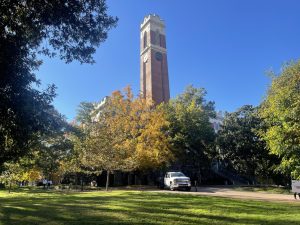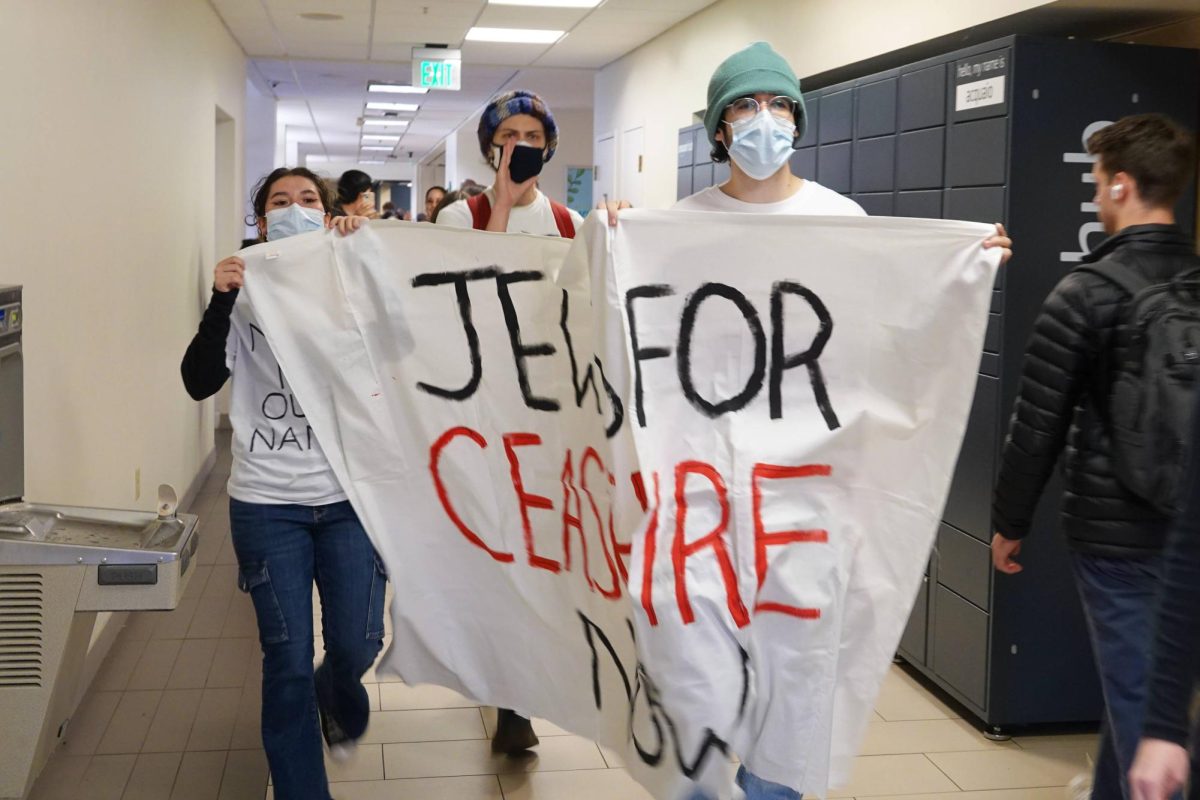Graduate students at the Vanderbilt Divinity School have been organizing nonviolent direct action on campus since Nov. 30 in favor of a ceasefire in Gaza. Students for Justice in Palestine also held a flag exhibit and “die-in” on Dec. 7 — exactly two months after Hamas’s Oct. 7 attacks — to raise awareness of the over 16,000 Palestinians who have been killed in Gaza.
The graduate student demonstrations, staged in the Divinity School building, consisted of flyers posted throughout the building — including a list of the names of Palestinian victims in Gaza hanging from the stairs over three stories. The SJP exhibit consisted of small flags containing the names of children killed in Gaza. Beside the flags were a 20-person “die-in” — a form of protest in which participants simulate being dead — and posters calling for ceasefire and drawing attention to the thousands of Gazan civilian deaths.
Vanderbilt Hillel sent an email to its members on Dec. 8 discussing Hanukkah celebrations and responding to the SJP exhibit.
“We are aware of an anti-Israel demonstration which took place on campus yesterday and are dismayed that this event took place just prior to the start of Hanukkah,” the email reads. “Our Jewish students are undeterred in showing their Jewish pride and standing up against antisemitism.”
Divinity School demonstrations
Covering doors, hallways and the entrance to the Dean’s office, flyers in the Divinity School building called attention to the number of victims in the war, cited quotes from the Bible and called for “justice for Palestine” and a ceasefire.
Some posters hung up listed Vanderbilt Divinity School students Christiana Green, Vanderbilt Black Seminarians President; Maria C. Urias, Latinx Seminarians Vice President; Rachel Salmon, Methodist Student Association president; Frances Fitzgerald, an M.Div. student; and L. Sotolongo, Latinx Seminarians President, as organizers of the demonstration. Fitzgerald and Sotolongo did not respond to The Hustler’s request for comment, and Urias declined to comment.
“I think we expected other people to do something, possibly staff, possibly faculty, to do something or make a larger statement, and it just wasn’t happening. And we were kind of tired of being disappointed,” Green said. “But we also can only hold ourselves accountable because we also attend Vanderbilt, and we weren’t saying anything. So I think we were just kind of like, well, we’re gonna have to say something. We can’t just talk about other people not doing anything when we’re not doing anything.”
According to Green, the posters were originally hung up on Nov. 29 for a couple of hours before being removed by the university because they lacked attribution. She said they were put back up that night with the posters listing the students organizing the demonstration and then removed once again on Dec 1 due to being directly attached to walls. Green said the posters were rehung on bulletin boards unattached to the walls as of Dec. 5.
Salmon emphasized that the nonviolent direct action served a dual purpose of calling for a ceasefire and honoring the Divinity School’s roots.
“Vanderbilt Divinity School is the ‘Schola Prophetarum’ — the school of the prophets. In the Bible, prophets are faithful people who speak truth to power, no matter how painful it might have been,” Salmon said. “VDS is a justice-centered school, and we felt the need to remind ourselves that speaking out is the baseline of what we do here and who we are.”
Student organizers also mentioned the support they received for the protest from the James Lawson Institute for the Research and Study of Nonviolent Movements.
“We know in this building that there will always be a constant support of nonviolent direct action — well thought out, and well-intentioned nonviolent direct action — from the Lawson Institute,” Green said.
Dr. Phillis Sheppard, Executive Director of the Lawson Institute, said that the institute’s support has been in the form of guidance on how to approach nonviolent direct action.
“The way in which we are supportive is in communicating what nonviolent direct action means [and] the way in which you go about it, particularly from a Lawson perspective,” Sheppard said.
Green said the students plan to continue nonviolent direct action to call attention to the civilians being killed in Gaza.
“I think I just want to make it explicitly clear that while VDS might be taking the signs down, that is purely why we keep doing it and why we will continue to have direct action in this way because we feel it is our call as people, but specifically in this school, that we are supposed to speak up about things like this,” Green said. “We’re watching people be murdered for simply just being, and we can’t sit by and just let that happen.”
SJP exhibit and die-in
SJP installed small flags on the ground in the pattern and shape of the Palestinian flag. Each flag bore the name of a Palestinian child killed in Gaza, with the poster noting that the flags represented 15% of the thousands of children “martyred” in the region and 5% of the total number of Palestinian lives lost since Oct. 7. Students participating in the die-in also held papers over their faces with the names and images of Palestinian children who have been killed.
Beside the flags were posters detailing the crisis in the Middle East and calling for a ceasefire. The posters mentioned the over 7,000 Palestinians held in Israeli prisons, some without trial; 1.9 million Gazans displaced; and 16,300 Palestinians killed in the past 60 days. Two members of SJP also spoke at the exhibit.
“While we try to portray the extent of the losses in this exhibit, we cannot come close to understanding the losses people from Gaza experience, as their children, siblings, mothers, fathers, uncles and aunts are being torn away from them,” one SJP member, who was kept anonymous for protection from professional retribution, said.
The two students spoke on the humanitarian crisis in Gaza, citing a lack of fresh water — causing a spike in disease — and freedom of movement. Rafah is one of two main border crossings for Gazans and the only one not directly controlled by Israel. It serves as the passageway for medicine, food and supplies to enter Gaza and has been intermittently closed over the past month, with Egypt citing security concerns with opening it. The students also criticized Israel for launching strikes at Rafah, despite instructing northern Gazans to flee there for refuge.
The students further called on Vanderbilt students to stand with the citizens of Gaza and Palestine, calling the crisis a genocide stemming from settler colonialism — defined as a system of oppression that aims to displace a nation’s population, often indigenous, with a new settler population. Those who ascribe settler-colonialist status to Israel cite the mass displacement and dispossession of Palestinians during the 1948 Arab-Israeli war and the ongoing “illegal” Israeli settlement in territories it seized in the 1967 Arab-Israeli war. Others deny these allegations, arguing that Jews are also indigenous peoples who have maintained cultural ties to the land since the founding of Judaism 3,000 years ago.
“To our fellow Vandy students, we challenge you to speak up,” the SJP member said. “If you care about protecting, preserving and sustaining life — if you believe in justice and care about putting an end to violence in any capacity, then you will firmly, unconditionally be in solidarity with Palestine.”
Chabad, SSI and SJP banners
Vanderbilt Chabad and Vanderbilt’s chapter of Students Supporting Israel installed banners on Dec. 8 at Rand Wall calling for the Israeli hostages to be released and responding to the other protests’ calls for ceasefire.
“Where were those calling for ceasefire when Hamas violated the last two?” one banner reads. “There was a ceasefire on Oct. 6.”

Later that day, SJP put up its own banners calling attention to the civilian infrastructures that the Israel Defense Forces have bombed and the Palestinians being detained in Israel without trial.
“This is not a war. This is a genocide,” one banner reads.





























